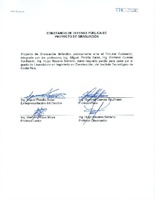Mostrar el registro sencillo del ítem
Guía para la evaluación de daños en edificaciones después de un sismo en Costa Rica
| dc.contributor.advisor | Cuevas-Kauffmann, Rommel | es |
| dc.contributor.author | Sanabria-Meneses, Katalina | |
| dc.date.accessioned | 2019-11-04T16:45:16Z | |
| dc.date.available | 2019-11-04T16:45:16Z | |
| dc.date.issued | 2019 | |
| dc.identifier.uri | https://hdl.handle.net/2238/10986 | |
| dc.description | Proyecto de Graduación (Licenciatura en Ingeniería en Construcción) Instituto Tecnológico de Costa Rica, Escuela de Ingeniería en Construcción, 2019. | es |
| dc.description.abstract | Costa Rica al encontrarse en una zona de alta sismicidad, requiere desarrollar una metodología única para evaluar el daño estructural de edificaciones que se vean afectadas después de un sismo. Es por ello que al proponer una herramienta para la evaluación del impacto estructura post-sismo se tiene como principal fin proteger la integridad de las personas, acatando una propuesta de actuación sobre un edificio específico: permitir, restringir o prohibir el acceso al edificio. Es decir, se pretende determinar en forma rápida pero detallada cuáles son aquellas parcialmente dañadas, cuya entrada deba ser restringida debido al riesgo de atentar contra la vida humana, cuáles presentan daños severos por los que sea necesario restringir por completo su uso y prevenir el acceso de personas para que su integridad no se vea comprometida, y cuáles edificaciones son las más seguras para permitir su ocupación. De este modo, se aspira por medio de esta herramienta contribuir a la generación de una base de datos que registre las edificaciones habitables, las edificaciones dañadas o aquellas que llegaron al colapso. Para una correcta evaluación, la metodología propuesta contará con un manual de uso que indique detalladamente el modo de captura de datos. Dicha metodología fue aplicada dos edificaciones existentes que presentaban daños estructurales. | es |
| dc.description.abstract | Costa Rica is located in an area of high seismicity, reason why it is so important to study the typological damage and usability characteristics of buildings, in the emergency phase following an earthquake, establishing a common language for the description of damage and vulnerability. Thus, developing a quick survey for post-earthquake damage assessment, short term countermeasures and usability assessment of buildings would be a vital resource, which’s main purpose would be to protect people’s integrity. In this way, the form will allow a first identification of the building usability. The observation and the interpretation of the apparent damage allows to identify the seriousness of modifications suffered by the structural and non-structural elements with respect to the reduction of safety of the building. In case of significant damage, it allows to immediately declare the no usability of the building for evident structural problems. In case of non-significant damages, on the other hand, it allows to understand which resistant mechanisms have been triggered so that building use can be restricted. Keeping track of the inspection and of the corresponding evaluation of risk and usability, will allow a better computerization of the data. With the aim of providing a tool for a correct evaluation and for a full awareness of the principles of the form, a manual which extends the procedures for preparing and carrying out the building survey is given. This methodology was applied to two existing buildings presenting structural damages as a consequence of a past earthquake. | es |
| dc.language.iso | spa | es |
| dc.publisher | Instituto Tecnológico de Costa Rica | es |
| dc.rights | acceso abierto | es |
| dc.subject | Evaluación | es |
| dc.subject | Daños | es |
| dc.subject | Sismos | es |
| dc.subject | Edificación | es |
| dc.subject | Evaluation | es |
| dc.subject | Damage | es |
| dc.subject | Post-earthquake | es |
| dc.subject | Buildings | es |
| dc.subject | Habitability | es |
| dc.subject | Research Subject Categories::TECHNOLOGY::Civil engineering and architecture::Building engineering | es |
| dc.title | Guía para la evaluación de daños en edificaciones después de un sismo en Costa Rica | es |
| dc.type | proyecto fin de carrera | es |


